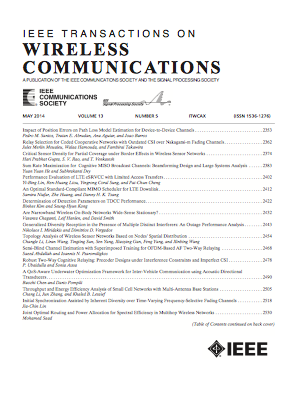RIS-Assisted Wideband Beamforming for Near-Field Terahertz Systems
IF 10.7
1区 计算机科学
Q1 ENGINEERING, ELECTRICAL & ELECTRONIC
引用次数: 0
Abstract
Reconfigurable intelligent surface (RIS)-assisted wideband terahertz (THz) communications are essential for achieving ultra-high data rates in sixth-generation (6G) networks. By adjusting the phase shifts of reflecting elements, reconfigurable intelligent surface (RIS) can effectively reshape wireless channels to enhance overall performance. However, two major challenges arise in RIS-assisted THz systems: 1) the dual beam split effect, where the large bandwidth causes subcarrier beam directions to diverge at both base station (BS) and RIS; and 2) the near-field effect, where the channel becomes a nonlinear function of both angle and distance. In this paper, we propose a novel beamforming technique, termed RIS-assisted wideband beamforming (RWB), to address these challenges and maximize data rates in RIS-assisted wideband THz systems. The RWB scheme leverages partially-connected true time delays (TTDs) and phase shifters (PSs) to generate frequency-dependent BS transmit beamforming vectors, while utilizing passive reflecting elements to control the frequency-invariant RIS reflect beamforming vector. By jointly optimizing the transmit and reflect beamforming vectors on the Riemannian manifold of unit-modulus phase shifts, RWB effectively mitigates both beam split and near-field effects. Numerical evaluations demonstrate that RWB achieves substantial data rate improvements over conventional wideband beamforming schemes.近场太赫兹系统的ris辅助宽带波束形成
可重构智能表面(RIS)辅助宽带太赫兹(THz)通信对于在第六代(6G)网络中实现超高数据速率至关重要。可重构智能表面(RIS)通过调整反射元件的相移,可以有效地重构无线信道,从而提高无线信道的整体性能。然而,RIS辅助太赫兹系统面临两个主要挑战:1)双波束分裂效应,其中大带宽导致基站(BS)和RIS的子载波波束方向发散;2)近场效应,通道成为角度和距离的非线性函数。在本文中,我们提出了一种新的波束形成技术,称为ris辅助宽带波束形成(RWB),以解决这些挑战并最大化ris辅助宽带太赫兹系统的数据速率。RWB方案利用部分连接的真实时间延迟(TTDs)和移相器(ps)来生成频率相关的BS发射波束形成矢量,同时利用无源反射元件来控制频率不变的RIS反射波束形成矢量。通过在单位模相移的黎曼流形上共同优化发射和反射波束形成矢量,RWB有效地减轻了波束分裂和近场效应。数值评估表明,相对于传统的宽带波束形成方案,RWB实现了显著的数据速率提高。
本文章由计算机程序翻译,如有差异,请以英文原文为准。
求助全文
约1分钟内获得全文
求助全文
来源期刊
CiteScore
18.60
自引率
10.60%
发文量
708
审稿时长
5.6 months
期刊介绍:
The IEEE Transactions on Wireless Communications is a prestigious publication that showcases cutting-edge advancements in wireless communications. It welcomes both theoretical and practical contributions in various areas. The scope of the Transactions encompasses a wide range of topics, including modulation and coding, detection and estimation, propagation and channel characterization, and diversity techniques. The journal also emphasizes the physical and link layer communication aspects of network architectures and protocols.
The journal is open to papers on specific topics or non-traditional topics related to specific application areas. This includes simulation tools and methodologies, orthogonal frequency division multiplexing, MIMO systems, and wireless over optical technologies.
Overall, the IEEE Transactions on Wireless Communications serves as a platform for high-quality manuscripts that push the boundaries of wireless communications and contribute to advancements in the field.

 求助内容:
求助内容: 应助结果提醒方式:
应助结果提醒方式:


